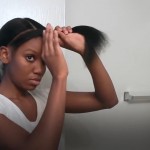My Edges Are Gone! How Do I Get Them Back? | Repairing Damaged Edges
Nurturing Your Crown: Understanding and Repairing Damaged Edges in African American Women’s Hair
As a professional hair stylist, I understand the significance of healthy edges in African-American women’s hair. Edges, also known as the hairline, play a pivotal role in framing one’s face and enhancing overall beauty. However, many African American women face the challenge of damaged edges, which can lead to thinning, breakage, and receding hairlines. In this article, we will explore the causes of damaged edges and provide a comprehensive guide on how to repair them, ensuring that your crown regains its natural beauty and vitality.
Understanding the Structure of Hair Edges
Before delving into the causes and remedies for damaged edges, it’s essential to grasp the intricate structure of hair follicles and edges. The hair follicles along your hairline are smaller and more delicate than those on the rest of your scalp. Additionally, hair growth patterns can vary significantly among individuals, making it essential to adopt a personalized approach to edge care. African American women often have unique challenges related to their hair type, including texture and density, which can impact the health of their edges.
Common Causes of Damaged Edges
- Traction Alopecia: One of the primary culprits behind damaged edges is traction alopecia, which occurs due to tight hairstyles. Braids, weaves, and extensions, while stylish and protective, can exert excessive tension on the hairline, leading to breakage and thinning. Opt for low-tension protective styles to reduce the risk of traction alopecia.
- Chemical Damage: Relaxers, perms, and hair dyes can weaken the hair shaft, making it more susceptible to damage. Frequent use of these chemicals can harm your edges over time. Consider using gentler, natural hair care alternatives, and limit the use of harsh chemicals to maintain healthy edges.
- Heat Styling: Excessive use of heat styling tools such as straighteners and curling irons can cause hair to become brittle and prone to breakage. Whenever possible, embrace heat-free styling options and use heat protectants when styling with hot tools.
- Poor Hair Care Practices: Neglecting proper hair care can also contribute to damaged edges. Lack of moisture, excessive brushing, and rough handling can weaken the hairline. Invest in hydrating products, be gentle when detangling, and use satin or silk pillowcases to reduce friction.
Recognizing the Signs of Damaged Edges
To address damaged edges effectively, it’s crucial to recognize the signs early on. Some common indicators of damaged edges include:
- Thinning hairline: If you notice your hairline becoming sparser and less defined, it’s a sign of damage.
- Breakage and split ends: Split ends along the hairline are indicative of weakened edges.
- Receding edges: A receding hairline, where the hair pulls back from the forehead, is a clear sign of damage.
- Scalp irritation and inflammation: Itchy, flaky, or inflamed skin around the hairline can signify underlying issues that need attention.
The Importance of Early Intervention
Addressing damaged edges as soon as you notice them is crucial for several reasons. First and foremost, it prevents further damage from occurring. Early intervention also helps boost your confidence and self-esteem by maintaining the aesthetic appeal of your hairline. Moreover, caring for your edges contributes to the overall health of your hair, ensuring that it remains strong and vibrant.
Repairing Damaged Edges: Step-by-Step Guide
- Gentle Cleansing and Conditioning: Start your journey to healthy edges by choosing the right products for your hair type. Use sulfate-free shampoos and hydrating conditioners that promote moisture retention. When washing, be gentle to avoid further damage.
- Protective Styling Alternatives: If you love protective styles, opt for low-tension braids and twists that reduce stress on your edges. Additionally, explore natural styles that promote hair growth, allowing your edges to recover while staying stylish.
- Proper Moisturization: Moisture is key to hair health. Use hydrating products, including leave-in conditioners and oils, to keep your edges well-hydrated. Seal in moisture with a light oil or butter to prevent dryness.
- Nourishing Your Scalp: Regular scalp massages can stimulate blood flow and encourage hair growth. Consider using essential oils like castor oil, peppermint oil, or rosemary oil to nourish your edges and promote regrowth.
- Avoiding Harmful Styling Practices: Minimize the use of heat styling tools, as excessive heat can further damage your edges. Explore heat-free styling options like braiding, twisting, or natural curls to achieve the look you desire while protecting your edges.
Dietary and Lifestyle Tips for Healthy Edges
Maintaining healthy edges goes beyond hair care products and practices. Your diet and lifestyle choices can significantly impact the condition of your hairline:
- Nutrient-rich diet for hair growth: Consume a balanced diet rich in vitamins, minerals, and protein. Foods like leafy greens, salmon, eggs, and nuts can promote hair growth and strength.
- Hydration and its impact on hair health: Drink plenty of water to keep your hair and scalp hydrated from within. Proper hydration supports overall hair health.
- Stress management and its role in hair care: High-stress levels can contribute to hair problems, including damaged edges. Practice stress-reduction techniques such as meditation, yoga, or deep breathing exercises to promote hair health.
Seeking Professional Help
If your damaged edges require more than at-home care, consider consulting a dermatologist or trichologist. These professionals can assess your condition and recommend medical treatments or procedures tailored to your needs. Early intervention by a specialist can make a significant difference in your edge’s recovery.
Maintaining Healthy Edges Long-Term
To ensure the long-term health of your edges, maintain a consistent hair care routine, including regular trims to prevent split ends from traveling up the hair shaft. Embrace your natural beauty, celebrate your unique hair texture, and share your knowledge and support within the African-American hair community.
In conclusion, understanding the causes of damaged edges and following a comprehensive care routine is essential for maintaining the beauty and vitality of your hairline. By recognizing the signs of damage early, adopting healthy hair care practices, and making mindful dietary and lifestyle choices, you can repair and protect your edges, ensuring that they frame your face with confidence and grace. Remember that healthy edges are a reflection of your overall hair health, and with dedication and care, you can nurture your crown to its fullest potential.












